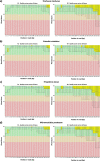Liver transcriptome resources of four commercially exploited teleost species
- PMID: 32636445
- PMCID: PMC7340784
- DOI: 10.1038/s41597-020-0565-9
Liver transcriptome resources of four commercially exploited teleost species
Abstract
The generation of omic resources is central to develop adequate management strategies for species with economic value. Here, we provide high-coverage RNA-seq datasets of liver tissue (containing between 80,2 and 88,4 million of paired-end reads) from four wildtype teleost species with high commercial value: Trachurus trachurus (TTR; Atlantic horse mackerel), Scomber scombrus (SSC; Atlantic mackerel), Trisopterus luscus (TLU; pout), and Micromesistius poutassou (MPO; blue whiting). A comprehensive assembly pipeline, using de novo single and multi-kmer assembly approaches, produced 64 single high-quality liver transcriptomes - 16 per species. The final assemblies, with N50 values ranging from 2,543-3,700 bp and BUSCO (Benchmarking Universal Single-Copy Orthologs) completeness values between 81.8-86.5% of the Actinopterygii gene set, were subjected to open reading frame (ORF) prediction and functional annotation. Our study provides the first transcriptomic resources for these species and offers valuable tools to evaluate both neutral and selected genetic variation among populations, and to identify candidate genes for environmental adaptation assisting in the investigation of the effects of global changes in fisheries.
Conflict of interest statement
The authors declare no competing interests.
Figures


References
-
- Begg, G. A. & Waldman, J. R. An holistic approach to fish stock identification. In Fisheries Research43, 35–44 (Elsevier, 1999).
-
- Cadrin, S. X., Kerr, L. A. & Mariani, S. Stock Identification Methods: An Overview. In Stock Identification Methods: Applications in Fishery Science: Second Edition 1–5 (Elsevier Inc., 2013).
Publication types
MeSH terms
LinkOut - more resources
Full Text Sources
Research Materials
Miscellaneous

